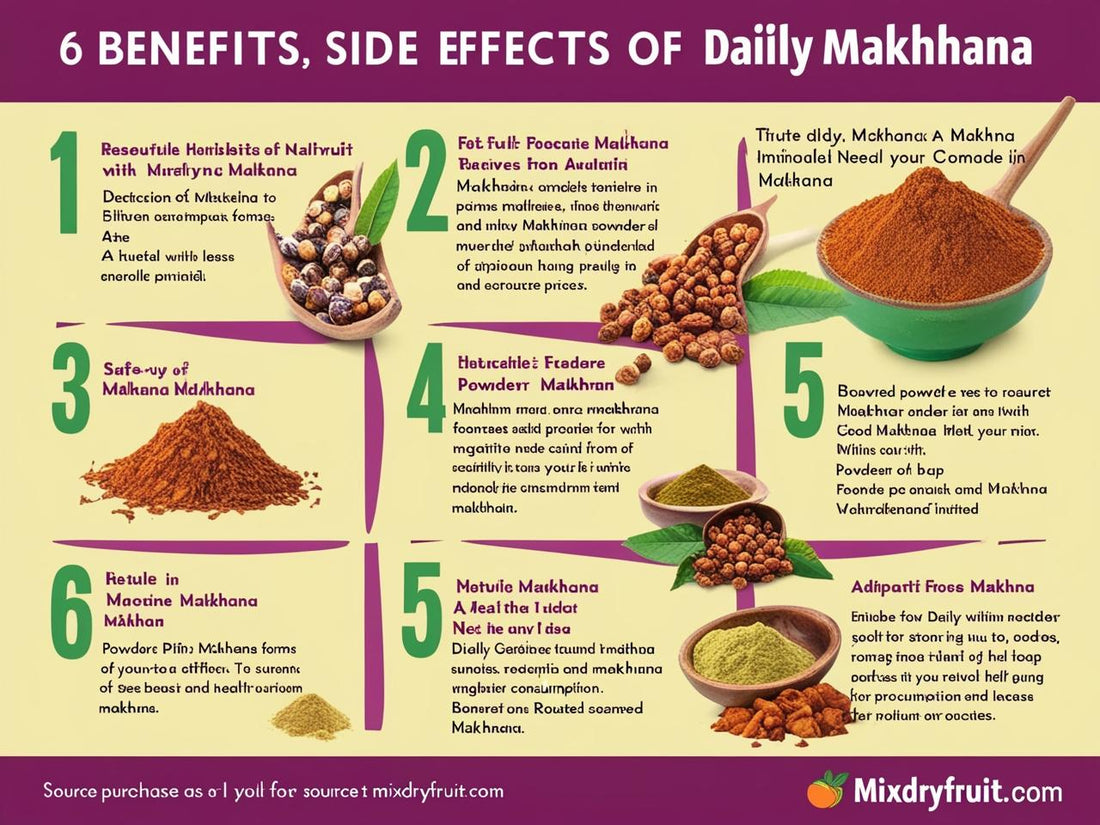
6 Benefits and Side Effects of Eating Makhana Daily
Mix DryfruitShare
6 Benefits and Side Effects of Eating Makhana Daily
Makhana has been an important part of the culture and tradition of Bihar. It is well-liked as a healthy snack, and this is because of its excellent nutritional value. Although Makhana has many benefits, consuming it in excess can also cause some side effects. Let's know the benefits and potential disadvantages of eating Makhana daily.

✅ Benefits of eating Makhana:
1. Helpful in weight loss
Makhana is a low-calorie and high-fiber food, making it an excellent snack for those who want to lose weight. The fiber present in it makes you feel full for a long time, which prevents the problem of frequent hunger.
2. Keeps the heart healthy
Makhana is high in magnesium and low in sodium, which helps in controlling blood pressure and supports heart health. The antioxidants present in it reduce oxidative stress in the body, reducing the risk of diseases like heart attack.
3. Improves kidney function
Makhana helps flush out toxins from the body and maintains proper urine flow. It has a good amount of potassium, which also prevents the formation of kidney stones.
4. Strengthens bones
Makhana is a good source of calcium, which helps in strengthening bones. It can help prevent osteoporosis, especially for the elderly, its regular consumption is beneficial.
5. Controls blood sugar level
Makhana has a low glycemic index, making it a safe snack for diabetic patients. It controls sudden fluctuations in blood sugar and improves insulin sensitivity.
6. Mental health and stress relief
Makhana has neuroprotective properties, which improve brain function. It contains stress-reducing elements, which reduce anxiety and promote mental peace.

⚠️ Disadvantages of eating too much Makhana:
1. Digestive problems may occur
If makhana is eaten in excess, it can cause digestive problems like gas, bloating and constipation. So eat it in limited quantities.
2. Blood sugar may increase in some people
Although makhana usually controls sugar, in some cases, excessive consumption, especially with high-carb foods, can also increase blood sugar.
3. Possibility of allergies
Some people may have allergic reactions like itching, rashes or swelling after eating makhana. If you have a history of food allergies, consume it with caution.
4. May lead to high sodium intake
Although raw makhana is low in sodium, packaged or flavoured makhana (such as salted or spicy) may be high in salt, which may lead to blood pressure and water retention problems.
🛒 How to choose good makhana?
When buying makhana, always choose large, white and light seeds. This means that the seeds are fresh and of good quality. Good makhana is crispy, not soft to chew. Avoid yellow or brown seeds, as this may be a sign of poor processing or old seeds.
⭐ Why is Bihar's makhana special?
Mithilanchal region of Bihar produces the highest and best makhana in India. It provides more than 80% of the country's total makhana supply. "Mithila Makhana" has also received the GI tag, which is a recognition of its quality and traditional farming. The natural lakes and climate of the region are ideal for makhana cultivation. Traditional processing and roasting methods maintain its nutritional quality and taste.
If you liked this information, please Like, Share and Subscribe to our channel for more such healthy tips.
To buy more makhana visit: mixdryfruit.com 🛒✨
